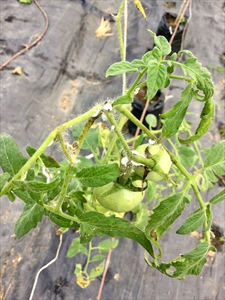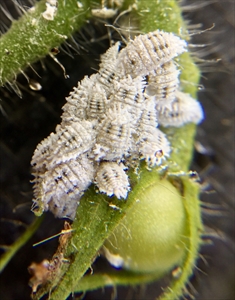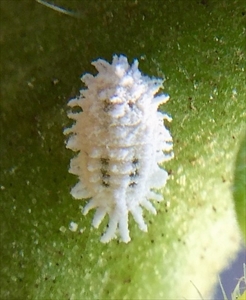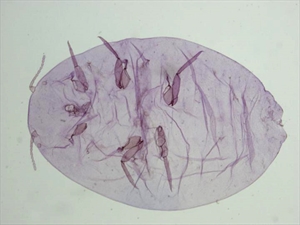Cotton mealybug, Solenopsis mealybug
Pacific Pests, Pathogens, Weeds & Pesticides - Online edition
Pacific Pests, Pathogens, Weeds & Pesticides
Cotton mealybug (373)
Phenacoccus solenopsis. It is possible that different biotypes exist in the Americas compared to Asia.
Asia, Africa, North, South and Central America, the Caribbean, Europe, Oceania. It is recorded from Australia (Queensland), Fiji (possibly), and New Caledonia. The identification of the mealybug in Fijiis tentative. It was based of images sent to an expert of the Pseudococcidae.
Wide, over 200 hosts in more than 50 plant families are known hosts; it is especially a pest of cotton, okra, Hibiscus species, papaya, and also found on plants in the potato (Solanaceae) family, e.g., capsicum, eggplant, tobacco, tomato. It occurs on a number of weeds. Note, this mealybug is found on the roots of plants as well as above ground, on stems and leaves.
The nymphs and adults do the damage by sucking sap from roots, leaves and stems. Heavy infestations cause stunting and distorted leaves, which turn yellow and fall. Flowers and fruits, too, are damaged and fall from infestations. In addition, the mealybug produces large amounts of honeydew as it feeds. This falls onto leaves and stems and is colonised by sooty mould fungi so that surfaces become black.
Because of the honeydew, the mealybug has a strong beneficial relationship with ants, especially with the red imported fire ant, Solenopsis invicta (see Fact Sheet no. 363). It is said to gain more honeydew than other species. The ants tend the mealybugs for honeydew, and in return the mealybugs receive protection from parasitoids and predators.
There are both males and females. Females lay eggs (up to 500 in a life of 3 months) into an ovisac – made of cottony and sticky wax - attached to the end of the insect. Crawlers (tiny first nymphs) emerge from the eggs and disperse to leaves, stems and roots. On cotton, they are also found around the bolls.
The crawlers go through several moults, but adult females and males are quite different. The adult female is 2.5 mm long and covered in a powdery wax. The body has 18 pairs of waxy filaments at the margin, and there are characteristic spots on the top surface (Photos 3-5). The males start as crawlers but after two moults develop a white cylindrical silken cocoon and emerge as fly-like insects with wings and long antennae. They last 1-2 days, sufficient time to mate.
Spread is by crawlers and adults in rain and wind, and on clothing and machinery. Crawlers can spread on birds and even other insects. Long distance spread is associated with the movement of nursery stock, domestically and internationally.
The impact of this pest is due to its rapid multiplication rate, a waxy body protecting it from natural enemies and pesticides, a small size allowing it to hide in plant crevices, and an ability to feed on many plant species.
Major crop losses have occurred on cotton in Pakistan and India. In 2005, for instance, losses in these countries were put at 14%. In following years, high losses have also been reported in Bt cotton, forcing farmers to use insecticides, increasing costs and contaminating water supplies.
Look for the pale-yellow body of the adult female below the white powdery wax. Look for mealybugs and waxy secretions on clumped leaves, and on stems above-ground and just below the soil surface. Look for the dark spots on the back: two at the front and six behind. Look for the 18 pairs of waxy filaments around the margin. Slide-mounted stained preparations are needed for identification (Photo 6).
To monitor populations of the mealybugs, sticky traps can be placed in and around fields.
NATURAL ENEMIES
Several parasitoids species (e.g., Chalcaspos, Cheiloneurus, and Aprostocetus in the USA, and Aenasius and Paranathrix in India) have been investigated as biocontrols of this mealybug. Aenasius bambawalei is the most important in parts of India with parasitism reaching 70%. A related species, Aenasius arizonensis, has given satisfactory control in Israel.
Predators include ladybird beetles (e.g., Cryptolaemus montrouzieri, and Harmonia and Rodolia species) that attack eggs and crawlers, and lacewing larvae that feed on eggs.
CULTURAL CONTROL
Note, an integrated pest management program is needed to manage outbreaks of this mealybug. The IPM program needs to include control of ants. The close association of this mealybug and the red imported ant is mentioned above; in Fiji, the white-footed ant (Technomyrmex species) plays a similar role (see Fact Sheet no. 360).
Before planting:
- Ensure that seedling are free from the mealybug in the nursery and when field planted.
- Remove weeds from around nurseries and field plots.
- Remove any unharvested plants in the field, those that have grown from the previous crop.
During growth:
- Do not plant near old infested crops.
- Do not plant downwind from infested crops as they will become infested by crawlers carried on the wind.
- Handpick or prune infested leaves, branches or stems when mealybugs are first seen and infestations are low. Burn or bury infested plant parts.
- Remove weeds (especially Parthenium) from within and around plantings which may harbour infestations of the mealybug.
- Discourage farmers from planting okra around fields of cotton.
- Control ants: (i) Trim trees and shrubs that surround nests to prevent bridges to other vegetation, or to touch exterior walls; (ii) use hot water at 47°C (and above) to kill ants. Hot water up to 49°C will not damage plants; (iii) a more extreme method is to use fire to destroy the nests; or (iv) apply pesticides (see Fact Sheet no. 360).
After harvest:
- Collect, burn or bury the remains of crops after harvest.
- Do not plant consecutive susceptible crops; if possible, leave a gap of at least 2 years.
CHEMICAL CONTROL
Use horticultural oil (made from petroleum), white oil (made from vegetable oil), or soap solution on plants infested with mealybugs (see Fact Sheet no. 56).
- White oil:
- 3 tablespoons (1/3 cup) cooking oil in 4 litres water
- ½ teaspoon pure hand soap, not detergent
- Shake well and use.
- Soap:
- Use soap (pure soap, not detergent):
- 5 tablespoons of soap in 4 litres water.
- Commercial horticultural oil can also be used. White oil, soap and horticultural oil sprays work by blocking the breathing holes of insects causing suffocation and death. Spray the undersides of leaves; the oils must contact the insects. A second application of soap or oils may be necessary after 3-4 weeks.
- The addition of malathion is useful against scales insects, but it is likely to kill natural enemies. Malathion should be avoided, if possible.
- Use spinosad, a natural insecticide produced from a group of organisms between bacteria and fungi, and used in organic agriculture.
- Use synthetic pyrethroid insecticides; they are likely to be effective against the crawlers, but they are difficult to see as they are so small. Synthetic pyrethroids are likely to kill natural enemies. They should be avoided, if possible, but may be useful against colonies of ants, especially if the ant species is ground nesting (see Fact Sheet no. 360) for more information on chemical control of ants).
____________________
When using a pesticide, always wear protective clothing and follow the instructions on the product label, such as dosage, timing of application, and pre-harvest interval. Recommendations will vary with the crop and system of cultivation. Expert advice on the most appropriate pesticides to use should always be sought from local agricultural authorities.
AUTHOR Grahame Jackson & Mani Mua
Information from CABI (2018) Phenacoccus solenopsis (cotton mealybug). Crop Protection Compendium. (https://www.cabi.org/cpc/datasheet/109097); and Scalenet. Phenacoccus solenopsis Tinsley 1898 (Pseudococcidae: Phenacoccus. (http://scalenet.info/catalogue/Phenacoccus%20solenopsis/); and from Phenacoccus solenopsis Tinsley. Plant Pests of the Middle East. (http://www.agri.huji.ac.il/mepests/pest/Phenacoccus_solenopsis/). Photo 6 Buamas C (2010) Solenopsis mealybug (Phenacoccus solenopsis): PaDIL - (http://www.padil.gov.au).
Produced with support from the Australian Centre for International Agricultural Research under project HORT/2016/185: Responding to emerging pest and disease threats to horticulture in the Pacific islands, implemented by the University of Queensland and the Secretariat of the Pacific Community.









